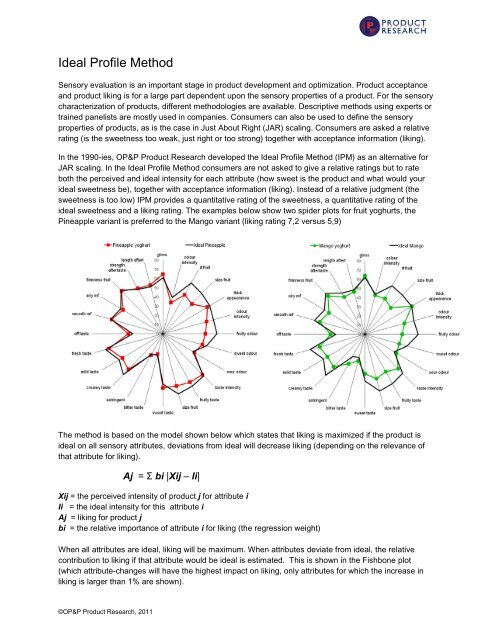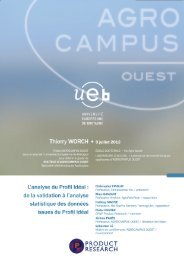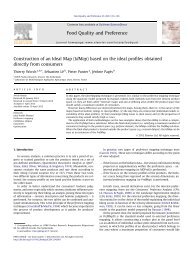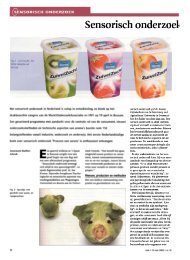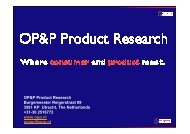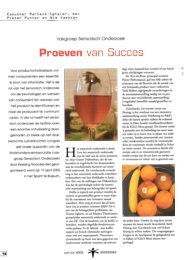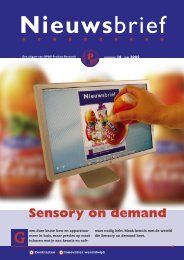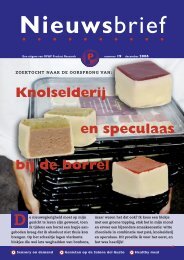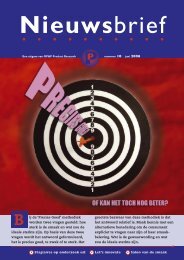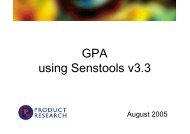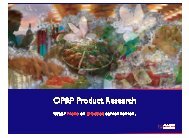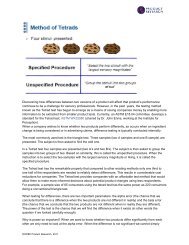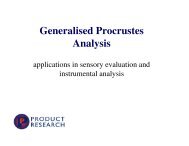Ideal Profile Method - OP&P Product Research
Ideal Profile Method - OP&P Product Research
Ideal Profile Method - OP&P Product Research
Create successful ePaper yourself
Turn your PDF publications into a flip-book with our unique Google optimized e-Paper software.
<strong>Ideal</strong> <strong>Profile</strong> <strong>Method</strong><br />
Sensory evaluation is an important stage in product development and optimization. <strong>Product</strong> acceptance<br />
and product liking is for a large part dependent upon the sensory properties of a product. For the sensory<br />
characterization of products, different methodologies are available. Descriptive methods using experts or<br />
trained panelists are mostly used in companies. Consumers can also be used to define the sensory<br />
properties of products, as is the case in Just About Right (JAR) scaling. Consumers are asked a relative<br />
rating (is the sweetness too weak, just right or too strong) together with acceptance information (liking).<br />
In the 1990-ies, OP&P <strong>Product</strong> <strong>Research</strong> developed the <strong>Ideal</strong> <strong>Profile</strong> <strong>Method</strong> (IPM) as an alternative for<br />
JAR scaling. In the <strong>Ideal</strong> <strong>Profile</strong> <strong>Method</strong> consumers are not asked to give a relative ratings but to rate<br />
both the perceived and ideal intensity for each attribute (how sweet is the product and what would your<br />
ideal sweetness be), together with acceptance information (liking). Instead of a relative judgment (the<br />
sweetness is too low) IPM provides a quantitative rating of the sweetness, a quantitative rating of the<br />
ideal sweetness and a liking rating. The examples below show two spider plots for fruit yoghurts, the<br />
Pineapple variant is preferred to the Mango variant (liking rating 7,2 versus 5,9)<br />
The method is based on the model shown below which states that liking is maximized if the product is<br />
ideal on all sensory attributes, deviations from ideal will decrease liking (depending on the relevance of<br />
that attribute for liking).<br />
Aj = Σ bi |Xij – Ii|<br />
Xij = the perceived intensity of product j for attribute i<br />
Ii = the ideal intensity for this attribute i<br />
Aj = liking for product j<br />
bi = the relative importance of attribute i for liking (the regression weight)<br />
When all attributes are ideal, liking will be maximum. When attributes deviate from ideal, the relative<br />
contribution to liking if that attribute would be ideal is estimated. This is shown in the Fishbone plot<br />
(which attribute-changes will have the highest impact on liking, only attributes for which the increase in<br />
liking is larger than 1% are shown).<br />
©OP&P <strong>Product</strong> <strong>Research</strong>, 2011
Fishbone plots for the two yoghurts. The red diamonds indicate the deviation from ideal (right axis,<br />
absolute ratings), the yellow bars indicate how much liking would improve if that attribute would be ideal<br />
(left axis, percentage increase in liking).<br />
In the past 15 years, OP&P <strong>Product</strong> <strong>Research</strong> has performed more than 1200 <strong>Ideal</strong> <strong>Profile</strong> tests (both in<br />
the Netherlands and in other countries) for almost any kind of product and for a large number of<br />
companies.<br />
In 2012, Thierry Worch hopes to finish his PhD on the <strong>Ideal</strong> <strong>Profile</strong> <strong>Method</strong>. You can download different<br />
publications and papers on the method from the website.<br />
©OP&P <strong>Product</strong> <strong>Research</strong>, 2011


